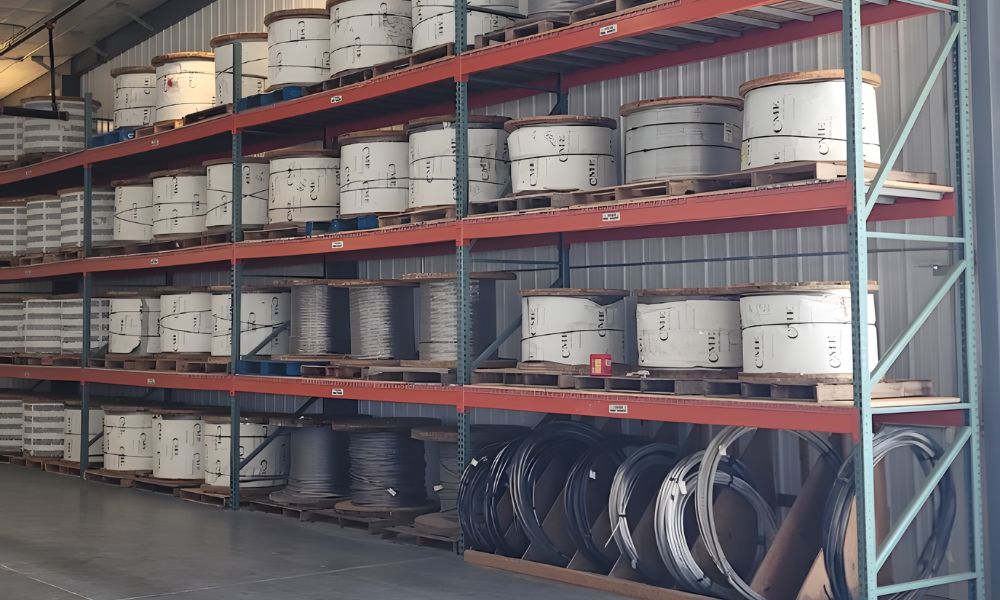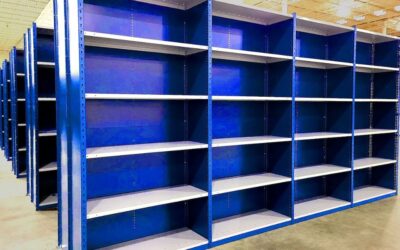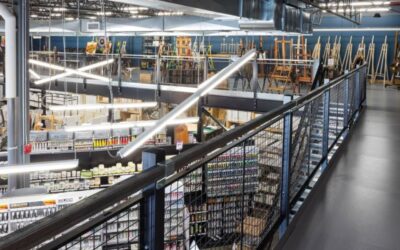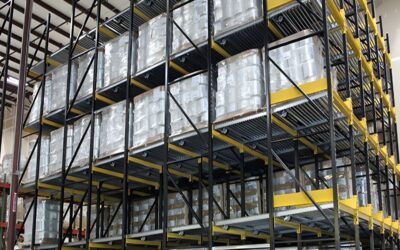The Impact of Shelving Layout on Warehouse Safety

The layout of your warehouse shelving plays a pivotal role in maintaining a safe and efficient work environment. When you thoughtfully design and arrange your shelving systems, they support productivity while also helping you minimize risks that can lead to accidents or injuries. A well-organized shelving layout ensures you use every square foot of your warehouse wisely, reducing clutter and improving access to essential items.
Every decision in your warehouse—from the placement of shelves to the pathways between them—affects the safety of your workers and the overall functionality of your operations. Poorly planned layouts lead to delays, inefficiencies, and even hazardous situations, making safety-oriented shelving design a critical investment. Your shelving layout has a big impact on warehouse safety, so when you want safety and efficiency, optimizing your shelving is a must.
Adequate Aisle Widths
Shelving layouts should provide sufficient aisle space to ensure the safe and efficient movement of workers, forklifts, and other equipment. Narrow aisles can lead to bottlenecks, operational delays, and an increased risk of collisions or accidents, especially during high-demand periods.
Wider aisles, on the other hand, improve visibility and allow for smoother navigation, particularly in high-traffic areas of the warehouse. When designing aisle widths, consider the dimensions of your equipment, the volume of traffic, and the types of materials being handled to ensure optimal safety and efficiency.
Proper Weight Distribution
Always store heavier items on lower shelves and lighter items higher up to enhance stability and safety. This practice improves weight distribution, reducing the risk of shelving units tipping over during handling or in the event of accidental impact.
Additionally, it minimizes physical strain on workers who need to lift or move heavy items, as they can do so from a safer, more ergonomic position. Overloading higher shelves can lead to structural instability and dangerous accidents, so ensure your team follows load limits consistently.
Strategic Accessibility
Store frequently accessed items at convenient heights to eliminate anyone from excessive bending, stretching, or reaching. Placing these items at a convenient height reduces the risk of musculoskeletal injuries for workers over time. Items stored at awkward heights typically:
– Slow down workflows
– Increase handling errors
– Create unnecessary operational inefficiencies
When you organize your inventory thoughtfully and consider accessibility, you can improve both safety and productivity in daily operations. Utilize ergonomic principles to determine optimal shelving heights and placement.

Clear Signage and Labels
Every shelving system should incorporate clear, easy-to-read labels for aisles and shelf contents to help workers quickly locate items and reduce errors. Proper signage helps prevent misplaced items, which can lead to safety hazards such as falling objects, tripping risks, or blocked pathways.
Implementing a standardized labeling system, such as color-coded labels or barcodes, further streamlines inventory management and improves navigation within the warehouse. Ensure that signs are visible, durable, and regularly updated to reflect changes in stock or layout.
Stable Shelving Construction
You must build shelving units with high-quality, durable materials and install them according to safety standards to ensure stability. Poorly constructed or unstable shelves are more likely to collapse, endangering workers and leading to costly material losses.
Conduct regular inspections to identify signs of wear, damage, or instability and address these issues promptly. Promptly reinforce shelves with additional bracing or anchors where needed, especially in areas prone to heavy use or seismic activity.
Defined Emergency Exits
Shelving layouts must maintain clear and unobstructed pathways to emergency exits at all times. Blocked exits pose serious safety hazards, delaying evacuation during emergencies and putting lives at risk. Ensure emergency exits are clearly marked with highly visible signage and proper lighting to guide workers during potential low visibility conditions. Conduct periodic safety drills to confirm that exit routes remain accessible and workers are familiar with evacuation procedures.
Proper Lighting Design
Good lighting is essential for maintaining a safe and efficient workspace. Poor lighting can obscure hazards, making it harder for workers to navigate narrow aisles or locate items on densely packed shelves. Installing adequate overhead lighting ensures better visibility and reduces the risk of accidents. Motion-sensor lighting can be a valuable addition, as it illuminates spaces as needed while conserving energy.
Integration of Safety Barriers
Safety barriers are an essential feature of shelving layouts, protecting both workers and equipment. These barriers prevent forklifts, carts, or other moving equipment from unintentionally striking shelving units, which could cause damage or injury. Additionally, they help contain falling items in case of accidental impacts, reducing potential hazards.
Optimized Traffic Flow
Efficient traffic flow within a warehouse is crucial for minimizing congestion and reducing the risk of accidents. Shelving layouts should align with the natural movement patterns of workers and equipment, creating a consistent flow that avoids confusion.
Use clear directional signage and floor markings to guide workers and machinery through designated pathways. Regularly analyze traffic patterns to identify bottlenecks or inefficiencies and adjust layouts as needed to accommodate changes in workflow or operations.

Separation of Pedestrian and Equipment Areas
To enhance safety, it’s important to clearly define zones for pedestrian access and areas where forklifts or heavy machinery operate. This separation reduces the likelihood of accidents between workers and moving equipment, especially in busy areas. Try using physical dividers, safety barriers, or floor markings to maintain clear boundaries.
Additionally, train workers to adhere to these zones and establish protocols for crossing or entering equipment areas. Proper separation not only improves safety but also streamlines operations by reducing workflow interruptions.
Regular Maintenance Checks
Consistent inspections and maintenance are key to ensuring the safety and longevity of shelving systems. Look for signs of structural damage, debris, or loose components that could pose risks to workers or inventory. Address issues immediately to prevent accidents or further damage. Regular maintenance extends the lifespan of shelving units, reducing the need for costly repairs or replacements.
Load Capacity Awareness
Each shelving unit has a specified load capacity that must be strictly followed to maintain its structural integrity. Overloading shelves weakens their stability and increases the risk of sudden collapses, putting workers and materials at serious risk.
Clearly display load capacity limits on each shelving unit to ensure compliance and provide training to workers on proper loading practices. Also, regularly inspect shelves for signs of overloading, such as sagging or bending, and redistribute items as needed.
A well-planned shelving layout has a big impact on warehouse safety, serving as the backbone of a safe and efficient warehouse. By proactively organizing shelves with safety in mind, you dramatically reduce the likelihood of accidents while enhancing operational effectiveness.
Each detail of your shelving design—from aisle widths to load distribution—directly impacts worker safety, productivity, and overall workflow, and that’s where Midwest Warehouse Solutions can help you. Our warehouse shelving solutions are a strategic option that will benefit your employees, your business, and the long-term success of your operation. Thoughtful design today lays the foundation for a safer, more productive warehouse tomorrow.
Latest Blogs
How Modular Cabinets Enhance Warehouse Inventory Control
For more flexibility and management in your warehouse, discover how modular cabinets can improve workflow and inventory control with these features.
How Modular Cabinets Enhance Warehouse Inventory Control
For more flexibility and management in your warehouse, discover how modular cabinets can improve workflow and inventory control with these features.
Important Questions To Ask Before Hiring Mezzanine Builders
To achieve a layout that boosts work productivity, find out what kind of questions you should ask your mezzanine builders before they work in your warehouse.
Effective Strategies for Efficient Pallet Rack Installation
To optimize your warehouse layout, discover how to efficiently install a pallet rack system that maintains and improves work performance across your business.
Questions?
Let’s Chat About Your Warehouse Project Today!
Or all us at 515-635-1555
Save time. We will contact you
Provide your details, and we’ll help you find exactly what you need


